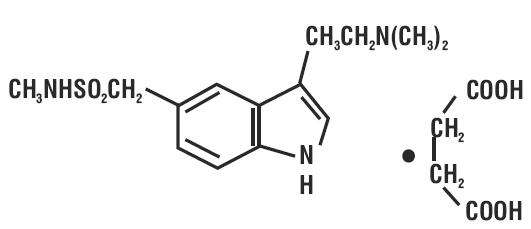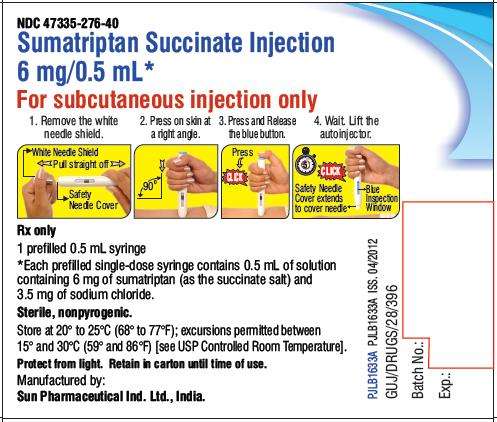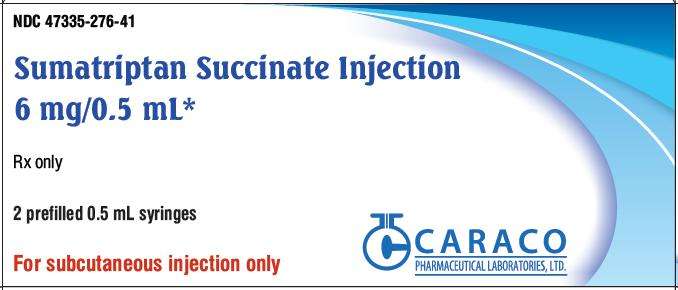Sumatriptan Succinate
Sumatriptan Succinate InjectionFor Subcutaneous Use Only.
FULL PRESCRIBING INFORMATION: CONTENTS*
- SUMATRIPTAN SUCCINATE DESCRIPTION
- CLINICAL PHARMACOLOGY
- CLINICAL TRIALS
- SUMATRIPTAN SUCCINATE INDICATIONS AND USAGE
- SUMATRIPTAN SUCCINATE CONTRAINDICATIONS
- WARNINGS
- PRECAUTIONS
- SUMATRIPTAN SUCCINATE ADVERSE REACTIONS
- DRUG ABUSE AND DEPENDENCE
- OVERDOSAGE
- SUMATRIPTAN SUCCINATE DOSAGE AND ADMINISTRATION
- HOW SUPPLIED
- PATIENT INFORMATION
- HOW TO USE
- PACKAGE LABEL.PRINCIPAL DISPLAY PANEL-DEVICE LABEL
- PACKAGE LABEL.PRINCIPAL DISPLAY PANEL-CARTON
FULL PRESCRIBING INFORMATION
SUMATRIPTAN SUCCINATE DESCRIPTION
1
 142132464
142132464CLINICAL PHARMACOLOGY
Mechanism of Action
11D231-2-12
1Corneal Opacities: Melanin Binding:
Pharmacokinetics
maxmax. maxmax
Special Populations
Renal Impairment:
Hepatic Impairment: maxmax
Age: PRECAUTIONS: Geriatric Use.
Race: max
Drug Interactions
Monoamine Oxidase Inhibitors:
Pharmacodynamics
Typical Physiologic Responses:
Blood Pressure: WARNINGS: Increase in Blood Pressure
Peripheral (small) Arteries:
Heart Rate:
Respiratory Rate:
CLINICAL TRIALS
Migraine:
| Sumatriptan Dose (mg) | % Patients With Relief |
% Patients With Relief |
% Patients With Relief |
% Patients With Relief |
Adverse Events Incidence (%) |
|---|---|---|---|---|---|
| Placebo |
5 |
15 |
24 |
21 |
55 |
| 1 |
10 |
40 |
43 |
40 |
63 |
| 2 |
7 |
23 |
57 |
43 |
63 |
| 3 |
17 |
47 |
57 |
60 |
77 |
| 4 |
13 |
37 |
50 |
57 |
80 |
| 6 |
10 |
63 |
73 |
70 |
83 |
| 8 |
23 |
57 |
80 |
83 |
93 |
| 1-Hour Data | Study 1 | Study 2 | ||
|---|---|---|---|---|
| Placebo (n = 190) | Sumatriptan 6 mg (n = 384) | Placebo (n = 180) | Sumatriptan 6 mg (n = 350) |
|
| Patients with pain relief (grade 0/1) |
18% |
70% |
26% |
70% |
| Patients with no pain |
5% |
48% |
13% |
49% |
| Patients without nausea |
48% |
73% |
50% |
73% |
| Patients without photophobia |
23% |
56% |
25% |
58% |
Patients with little or no clinical disability |
34% |
76% |
34% |
76% |
|
2-Hour Data
|
Study 1
|
Study 2
|
||
Placebo |
Sumatriptan 6 mg |
Placebo |
Sumatriptan 6 mg
|
|
| Patients with pain relief (grade 0/1) |
31% |
81% |
39% |
82% |
| Patients with no pain |
11% |
63% |
19% |
65% |
| Patients without nausea |
56% |
82% |
63% |
81% |
| Patients without photophobia |
31% |
72% |
35% |
71% |
Patients with little or no clinical disability |
42% |
85% |
49% |
84% |
Cluster Headache:
| Study 1 | Study 2 | ||||
|---|---|---|---|---|---|
| Placebo (n = 39) |
Sumatriptan 6 mg (n = 39) |
Placebo (n = 88) |
Sumatriptan 6 mg (n = 92) |
||
| Patients with pain relief (no/mild) | |||||
| 5 minutes postinjection |
8% |
21% |
7% |
23% (n = Number of headaches treated.) |
|
| 10 minutes postinjection |
10% |
49% (n = Number of headaches treated.) |
25% |
49% (n = Number of headaches treated.) |
|
| 15 minutes postinjection |
26% |
74% (n = Number of headaches treated.) |
35% |
75% (n = Number of headaches treated.) |
|
Figure 1. Time to Relief From Time of Injection*

*Patients taking rescue medication were censored at 15 minutes.
Other data suggest that sumatriptan treatment is not associated with an increase in early recurrence of headache, and that treatment with sumatriptan has little effect on the incidence of latter-occurring headaches (i.e., those occurring after 2, but before 18 or 24 hours).
SUMATRIPTAN SUCCINATE INDICATIONS AND USAGE
CONTRAINDICATIONS
SUMATRIPTAN SUCCINATE CONTRAINDICATIONS
Sumatriptan succinate injection should not be given intravenously because of its potential to cause coronary vasospasm.
Sumatriptan succinate injection should not be given to patients with history, symptoms, or signs of ischemic cardiac, cerebrovascular, or peripheral vascular syndromes. In addition, patients with other significant underlying cardiovascular diseases should not receive sumatriptan succinate injection. Ischemic cardiac syndromes include, but are not limited to, angina pectoris of any type (e.g., stable angina of effort and vasospastic forms of angina such as the Prinzmetal variant), all forms of myocardial infarction, and silent myocardial ischemia. Cerebrovascular syndromes include, but are not limited to, strokes of any type as well as transient ischemic attacks. Peripheral vascular disease includes, but is not limited to, ischemic bowel disease (see WARNINGS: Other Vasospasm-Related Events and WARNINGS: Risk of Myocardial Ischemia and/or Infarction and Other Adverse Cardiac Events).
Because sumatriptan succinate injection may increase blood pressure, it should not be given to patients with uncontrolled hypertension.
Sumatriptan succinate injection and any ergotamine-containing or ergot-type medication (like dihydroergotamine or methysergide) should not be used within 24 hours of each other, nor should sumatriptan succinate injection and another 5-HT1 agonist.
Sumatriptan succinate injection should not be administered to patients with hemiplegic or basilar migraine.
Sumatriptan succinate injection is contraindicated in patients with hypersensitivity to sumatriptan or any of its components.
Sumatriptan succinate injection is contraindicated in patients with severe hepatic impairment.
WARNINGS
Sumatriptan succinate injection should only be used where a clear diagnosis of migraine or cluster headache has been established. The prescriber should be aware that cluster headache patients often possess one or more predictive risk factors for coronary artery disease (CAD).Risk of Myocardial Ischemia and/or Infarction and Other Adverse Cardiac Events:
Sumatriptan should not be given to patients with documented ischemic or vasospastic CAD (see CONTRAINDICATIONS). It is strongly recommended that sumatriptan not be given to patients in whom unrecognized CAD is predicted by the presence of risk factors (e.g., hypertension, hypercholesterolemia, smoker, obesity, diabetes, strong family history of CAD, female with surgical or physiological menopause, or male over 40 years of age) unless a cardiovascular evaluation provides satisfactory clinical evidence that the patient is reasonably free of coronary artery and ischemic myocardial disease or other significant underlying cardiovascular disease. The sensitivity of cardiac diagnostic procedures to detect cardiovascular disease or predisposition to coronary artery vasospasm is modest, at best. If, during the cardiovascular evaluation, the patient’s medical history or electrocardiographic investigations reveal findings indicative of or consistent with coronary artery vasospasm or myocardial ischemia, sumatriptan should not be administered (see CONTRAINDICATIONS).
For patients with risk factors predictive of CAD who are determined to have a satisfactory cardiovascular evaluation, it is strongly recommended that administration of the first dose of sumatriptan injection take place in the setting of a physician’s office or similar medically staffed and equipped facility. Because cardiac ischemia can occur in the absence of clinical symptoms, consideration should be given to obtaining on the first occasion of use an electrocardiogram (ECG) during the interval immediately following sumatriptan succinate injection, in these patients with risk factors.
It is recommended that patients who are intermittent long-term users of sumatriptan and who have or acquire risk factors predictive of CAD, as described above, undergo periodic interval cardiovascular evaluation as they continue to use sumatriptan. In considering this recommendation for periodic cardiovascular evaluation, it is noted that patients with cluster headache are predominantly male and over 40 years of age, which are risk factors for CAD.
Drug-Associated Cardiac Events and Fatalities:
Premarketing Experience With Sumatriptan:
Postmarketing Experience With Sumatriptan:
CONTRAINDICATIONSDrug-Associated Cerebrovascular Events and Fatalities: Other Vasospasm-Related Events: Serotonin Syndrome:Increase in Blood Pressure: CONTRAINDICATIONSConcomitant Drug Use: CLINICAL PHARMACOLOGY: Drug Interactions: Monoamine Oxidase InhibitorsUse in Women of Childbearing Potential: PRECAUTIONS: PregnancyHypersensitivity: CONTRAINDICATIONS
PRECAUTIONS
General
WARNINGS: Risk of Myocardial Ischemia and/or Infarction and Other Adverse Cardiac EventsWARNINGS: Other Vasospasm-Related Events
WARNINGS: Drug-Associated Cerebrovascular Events and Fatalities
Binding to Melanin-Containing Tissues: CLINICAL PHARMACOLOGY: Melanin Binding
Corneal Opacities: CLINICAL PHARMACOLOGY: Corneal Opacities
Patients who are advised to self-administer sumatriptan succinate injection in medically unsupervised situations should receive instruction on the proper use of the product from the physician or other suitably qualified health care professional prior to doing so for the first time.
Information for Patients
PATIENT INFORMATION
Laboratory Tests
Drug Interactions
Selective Serotonin Reuptake Inhibitors/Serotonin Norepinephrine Reuptake Inhibitors and Serotonin Syndrome:WARNINGS
Migraine Prophylactic Medications:
Ergot-Containing Drugs: CONTRAINDICATIONS
Monoamine Oxidase-A Inhibitors:
CLINICAL PHARMACOLOGY: Drug Interactions: Monoamine Oxidase InhibitorsWARNINGS: Concomitant Drug Use
Drug/Laboratory Test Interactions
Sumatriptan is not known to interfere with commonly employed clinical laboratory tests.
Carcinogenesis, Mutagenesis, Impairment of Fertility
2
22
Pregnancy
Teratogenic Effects: Pregnancy Category C.2
Embryolethality: 2
2
Teratogenicity : 2
Nursing Mothers
Pediatric Use
Geriatric Use
WARNINGS: Risk of Myocardial Ischemia and/or Infarction and Other Adverse Cardiac Events
SUMATRIPTAN SUCCINATE ADVERSE REACTIONS
Serious cardiac events, including some that have been fatal, have occurred following the use of sumatriptan succinate injection or tablets. These events are extremely rare and most have been reported in patients with risk factors predictive of CAD. Events reported have included coronary artery vasospasm, transient myocardial ischemia, myocardial infarction, ventricular tachycardia, and ventricular fibrillation CONTRAINDICATIONSWARNINGS: Risk of Myocardial Ischemia and/or Infarction and Other Adverse Cardiac EventsPRECAUTIONS: General
WARNINGS: Increase in Blood Pressure
Incidence in Controlled Clinical Trials of Migraine Headache:
| Adverse Event | Percent of Patients Reporting | |
|---|---|---|
| Sumatriptan Succinate Injection 6 mg Subcutaneous (n = 547) |
Placebo (n = 370) |
|
| Atypical sensations |
42 |
9 |
| Tingling |
14 |
3 |
| Warm/hot sensation |
11 |
4 |
| Burning sensation |
7 |
<1 |
| Feeling of heaviness |
7 |
1 |
| Pressure sensation |
7 |
2 |
| Feeling of tightness |
5 |
<1 |
| Numbness |
5 |
2 |
| Feeling strange |
2 |
<1 |
| Tight feeling in head |
2 |
<1 |
| Cardiovascular |
||
| Flushing |
7 |
2 |
| Chest discomfort |
5 |
1 |
| Tightness in chest |
3 |
<1 |
| Pressure in chest |
2 |
<1 |
| Ear, nose, and throat |
||
| Throat discomfort |
3 |
<1 |
| Discomfort: nasal cavity/sinuses |
2 |
<1 |
| Injection site reaction |
59 |
24 |
| Miscellaneous |
||
| Jaw discomfort |
2 |
0 |
| Musculoskeletal |
||
| Weakness |
5 |
<1 |
| Neck pain/stiffness |
5 |
<1 |
| Myalgia |
2 |
<1 |
| Neurological |
||
| Dizziness/vertigo |
12 |
4 |
| Drowsiness/sedation |
3 |
2 |
| Headache |
2 |
<1 |
| Skin |
||
| Sweating |
2 |
1 |
Incidence in Controlled Trials of Cluster Headache:
Other Events Observed in Association With the Administration of Sumatriptan Succinate Injection:
Cardiovascular:
Endocrine and Metabolic:
Eye:
Gastrointestinal:
Musculoskeletal:
Neurological:
Respiratory:
Skin:
Urogenital:
Miscellaneous:
Other Events Observed in the Clinical Development of Sumatriptan:
Breasts:
Cardiovascular:
Ear, Nose, and Throat:
Endocrine and Metabolic:
Eye:
Gastrointestinal:
Hematological Disorders:
Mouth and Teeth:
Musculoskeletal:
Neurological:
Respiratory:
Skin:
Urogenital:
Miscellaneous:
Pain and Other Pressure Sensations:
Postmarketing Experience (Reports for Subcutaneous or Oral Sumatriptan): ADVERSE REACTIONS
Blood:
Cardiovascular: WARNINGS
Ear, Nose, and Throat:
Eye:
Gastrointestinal: WARNINGS
Hepatic:
Neurological:
Non-Site Specific: WARNINGS
Psychiatry:
Respiratory:
Skin: WARNINGS: Hypersensitivity
Urogenital:
DRUG ABUSE AND DEPENDENCE
OVERDOSAGE
CONTRAINDICATIONSCLINICAL PHARMACOLOGY: Pharmacokinetics
SUMATRIPTAN SUCCINATE DOSAGE AND ADMINISTRATION
WARNINGS: Concomitant Drug UseCLINICAL PHARMACOLOGY: Drug Interactions: Monoamine Oxidase Inhibitors
HOW SUPPLIED
Store at 20° to 25°C (68° to 77°F); excursions permitted between 15° and 30°C (59° and 86°F) [see USP Controlled Room Temperature]. Protect from light.
PATIENT INFORMATION
Information for the Patient
Sumatriptan Succinate Injection
What is sumatriptan succinate injection?
1
Talk to your healthcare provider before taking sumatriptan succinate injection
1. Risk factors for heart disease:
- high blood pressure,
- high cholesterol,
- obesity,
- diabetes,
- smoking,
- strong family history of heart disease,
- you are postmenopausal, or
- you are a male over 40 years of age.
2. Important questions to consider before taking sumatriptan succinate injection:
YES
- Are you pregnant? Do you think you might be pregnant? Are you trying to become pregnant? Are you using inadequate contraception? Are you breastfeeding?
- Do you have any chest pain, heart disease, shortness of breath, or irregular heartbeats? Have you had a heart attack?
- Do you have risk factors for heart disease (such as high blood pressure, high cholesterol, obesity, diabetes, smoking, strong family history of heart disease, or you are postmenopausal or a male over 40)?
- Have you had a stroke, transient ischemic attacks (TIAs), or Raynaud syndrome?
- Do you have high blood pressure?
- Have you ever had to stop taking this or any other medicine because of an allergy or other problems?
- Are you taking any other migraine medicines, including other 5 HT1 agonists (triptans) or any other medicines containing ergotamine, dihydroergotamine, or methysergide?
- Are you taking any medicine for depression or other disorders such as monoamine oxidase inhibitors, selective serotonin reuptake inhibitors (SSRIs), or serotonin norepinephrine reuptake inhibitors (SNRIs)? Common SSRIs are citalopram HBr (CELEXA®*), escitalopram oxalate (LEXAPRO®*), paroxetine (PAXIL®*), fluoxetine (PROZAC®*/SARAFEM®*), olanzapine/fluoxetine (SYMBYAX®*), sertraline (ZOLOFT®*), and fluvoxamine. Common SNRIs are duloxetine (CYMBALTA®*) and venlafaxine (EFFEXOR®*).
- Have you had, or do you have, any disease of the liver or kidney?
- Have you had, or do you have, epilepsy or seizures?
- Is this headache different from your usual migraine attacks?
Important points about sumatriptan succinate injection
1. The use of sumatriptan succinate injection during pregnancy:
2. How to use sumatriptan succinate injection:
3. What to do if you take an overdose:
4. How to store your medicine:
Some possible side effects of sumatriptan succinate injection
- Some patients feel pain or tightness in the chest or throat when using sumatriptan succinate injection. If this happens to you, then discuss it with your healthcare provider before using any more sumatriptan succinate injection. If the chest pain is severe or does not go away, call your healthcare provider right away.
- Call your healthcare provider right away if you have sudden and/or severe abdominal pain following sumatriptan succinate injection.
- Some people may have a reaction called serotonin syndrome when they use certain types of antidepressants, SSRIs or SNRIs, while taking sumatriptan succinate injection. Symptoms may include confusion, hallucinations, fast heartbeat, feeling faint, fever, sweating, muscle spasm, difficulty walking, and/or diarrhea. Call your doctor immediately if you have any of these symptoms after taking sumatriptan succinate injection.
- Shortness of breath; wheeziness; heart throbbing; swelling of eyelids, face, or lips; or a skin rash, skin lumps, or hives happens rarely. If it happens to you, then tell your healthcare provider right away. Do not take any more sumatriptan succinate injection unless your healthcare provider tells you to.
- Some people may feel tingling, heat, flushing (redness of face lasting a short time), heaviness, or pressure after using sumatriptan succinate injection. A few people may feel drowsy, dizzy, tired, or sick. If you have any of these symptoms, tell your healthcare provider at your next visit.
- You may have pain or redness at the site of injection, but this usually lasts less than an hour.
- If you feel unwell in any other way or have any symptoms that you do not understand, you should contact your healthcare provider right away.
®®®®®®®®®
Caraco Pharmaceutical Laboratories, Ltd.
Sun Pharmaceutical Ind. Ltd.
HOW TO USE
Autoinjector for Sumatriptan Succinate Injection, 6 mg/0.5 mL
Figure 1 (frontal view of autoinjector)

CAUTIONS:
Check .
Keep
Keep
Do not
NEVER
NEVER
Check
HOW TO USE THE AUTOINJECTOR
Figure 2

Figure 3
 Without Continue to hold firmly against the skin .
Without Continue to hold firmly against the skin .Figure 4

Figure 5

If the inspection window is not blue, do not try to use the autoinjector again.
If you suspect you have not received the full dose, do not repeat the injection using a new autoinjector.
Figure 6

NEVER ATTEMPT TO REUSE AN AUTOINJECTOR
PACKAGE LABEL.PRINCIPAL DISPLAY PANEL-DEVICE LABEL
NDC 47335-276-40
Sumatriptan Succinate Injection
6 mg/0.5 mL
For subcutaneous injection only.

PACKAGE LABEL.PRINCIPAL DISPLAY PANEL-CARTON
NDC 47335-276-41
Sumatriptan Succinate Injection
6 mg/0.5 mL
Rx only
2 prefilled 0.5 mL syringes
For subcutaneous injection only

Sumatriptan SuccinateSumatriptan Succinate INJECTION
| ||||||||||||||||||||||||||||||||||||||||||||||||||||||||||||||||||||||||||||
PLEASE, BE CAREFUL!
Be sure to consult your doctor before taking any medication!